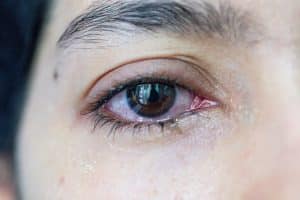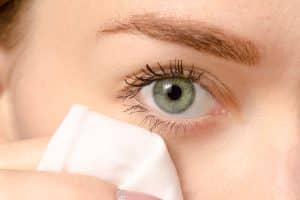If you’ve ever looked in the mirror and noticed that your eyes look red and irritated, you might have wondered why. When eyes become tinged with blood and inflamed like this, they’re often referred to as ‘bloodshot’. But what causes this appearance?
In this guide, you’ll learn all about the common causes of bloodshot eyes.
What can cause bloodshot eyes?
Bloodshot eyes can be disconcerting but they’re usually caused by something minor, such as dry eyes or allergies. However, in some cases, red eyes can be serious and will require medical help.[1]
In this guide, we go through some of the most common causes of bloodshot eyes.
Dry eyes
If, in addition to looking red, your eyes feel sore, blurry or watery, dry eyes may be to blame for the bloodshot appearance.[1] If this is the case, they may feel itchy, gritty and sensitive to light.[2]
Some people are more prone to dry eyes than others, including people who are over 50, contact lens wearers and people who spend a lot of time looking at screens.[2]
You can treat dry eyes at home by taking screen breaks, cleaning your eyelids regularly, using a humidifier to moisten the air and taking breaks from your contact lenses (if you wear them).[2]
Using eye drops can also provide relief. TheraTears® Dry or Tired Eye Drops, for example, have been specially formulated with hyaluronic acid to lubricate dry eyes. They also contain witch hazel, which has refreshing and soothing properties.
Eye strain
Eye strain is another common cause of bloodshot eyes. This is usually triggered by prolonged screen time. If you work with computers, use a smartphone or tablet a lot, or watch television for long durations, your bloodshot eyes might be accompanied by other symptoms of eye strain, such as headaches, blurred vision and sore facial muscles.[3]
There are various steps you can take to prevent eye strain. For example, you should:
- Take regular screen breaks
- Work under good lighting
- Adjust your computer display settings to make them more comfortable
- Wear your glasses or contact lenses
- Ensure the height, position and quality of your screen is optimal.[4]
Allergies
Your bloodshot eyes may be caused by an allergic reaction to something like pollen, dust or animal fur. If this is the case, you may also suffer from other common allergy symptoms, such as a runny nose, sneezing, tender or painful cheeks or eyes, or a sore forehead.[5]
Although allergies are usually mild, it’s important to be aware that they can be serious in some cases.[5]
If you think you have an allergy, you should seek advice from your GP. If you experience severe symptoms, such as swelling of the lips, mouth, tongue or throat, difficulty breathing or your skin turning blue, pale or grey, you should ring 999.[5]
Conjunctivitis
One of the main symptoms of conjunctivitis is a bloodshot appearance. That’s why it’s often known as ‘pink eye’ or ‘red eye’.[6] If you have this condition, you may also experience burning, itching and watery eyes. Your eyes may produce a pus that clings to your eyelashes, too.[6]
You can relieve the symptoms at home by washing your eyelids with cooled boiled water using a cotton pad – it’s important to use one pad per eye to avoid cross-contamination. Holding a cold flannel to your eyes can also help to soothe them. You should avoid wearing contact lenses while you have conjunctivitis.[6]
In some cases, you may need treatments such as eye drops or antihistamines to ease your symptoms. A pharmacist will be able to advise on the best treatment for you.[6]
Something in your eye
If you get a foreign object in your eye, for example, a wood chipping or a fragment of metal, you may find that your eye takes on a bloodshot appearance. Other signs could include eye pain, watering of the eye, blurred vision or loss of vision.
You may also experience bleeding or see a visible wound. If you experience this kind of eye injury, it’s important to seek emergency medical attention and not try to remove the object yourself as you may cause further damage.[7]
If you get something like dust or shampoo in your eyes, you could use an eye wash to flush your eyes out.[8]
While bloodshot eyes are usually not a major cause for concern, it’s important to seek medical advice if you’re worried about your eyes or if you’re not sure what is causing a blood-tinged appearance.
Resources
[1] – https://www.nhs.uk/conditions/red-eye/
[2] – https://www.nhs.uk/conditions/dry-eyes/
[3] – https://www.aao.org/eye-health/diseases/what-is-eye-strain
[4] – https://www.rnib.org.uk/your-eyes/how-to-keep-your-eyes-healthy/eye-safety/
[5] – https://www.nhs.uk/conditions/allergies/
[6] – https://www.nhs.uk/conditions/conjunctivitis/
[7] – https://www.sja.org.uk/get-advice/first-aid-advice/minor-illnesses-and-injuries/eye-injuries/
[8] – https://www.firstaid.co.uk/eye-wash-and-eye-baths-a-guide-to-flushing-your-eye/







